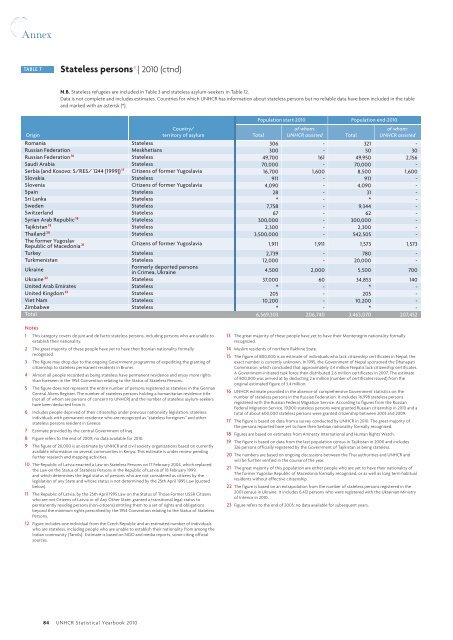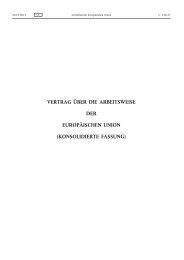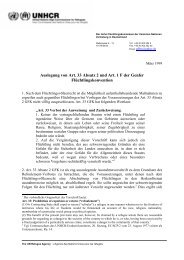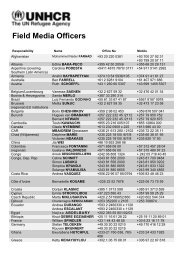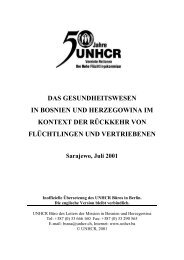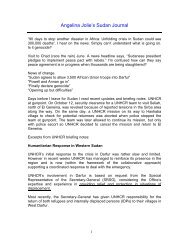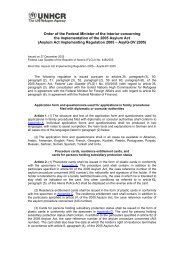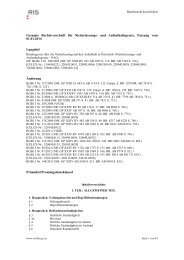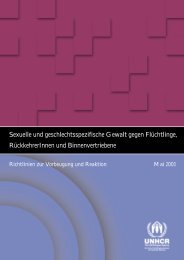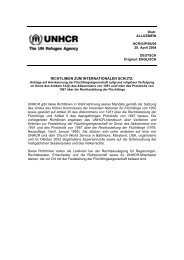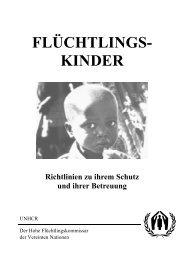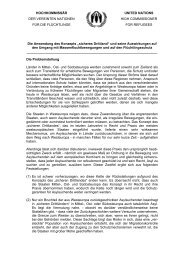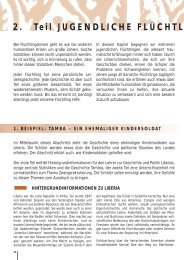UNHCR Statistical Yearbook 2010 61
UNHCR Statistical Yearbook 2010 61
UNHCR Statistical Yearbook 2010 61
- No tags were found...
Create successful ePaper yourself
Turn your PDF publications into a flip-book with our unique Google optimized e-Paper software.
AnnexTABLE 7Stateless persons 1 | <strong>2010</strong> (ctnd)OriginN.B. Stateless refugees are included in Table 3 and stateless asylum-seekers in Table 12.Data is not complete and includes estimates. Countries for which <strong>UNHCR</strong> has information about stateless persons but no reliable data have been included in the tableand marked with an asterisk (*).Country/territory of asylumPopulation start-<strong>2010</strong>Totalof whom:<strong>UNHCR</strong> assistedTotalPopulation end-<strong>2010</strong>of whom:<strong>UNHCR</strong> assistedRomania Stateless 306 - 321 -Russian Federation Meskhetians 300 - 50 30Russian Federation 16 Stateless 49,700 1<strong>61</strong> 49,950 2,156Saudi Arabia Stateless 70,000 - 70,000 -Serbia (and Kosovo: S/RES/ 1244 (1999)) 17 Citizens of former Yugoslavia 16,700 1,600 8,500 1,600Slovakia Stateless 911 - 911 -Slovenia Citizens of former Yugoslavia 4,090 - 4,090 -Spain Stateless 28 - 31 -Sri Lanka Stateless * - * -Sweden Stateless 7,758 - 9,344 -Switzerland Stateless 67 - 62 -Syrian Arab Republic 18 Stateless 300,000 - 300,000 -Tajikistan 19 Stateless 2,300 - 2,300 -Thailand 20 Stateless 3,500,000 - 542,505 -The former Yugoslav21Republic of MacedoniaCitizens of former Yugoslavia 1,911 1,911 1,573 1,573Turkey Stateless 2,739 - 780 -Turkmenistan Stateless 12,000 - 20,000 -UkraineFormerly deported personsin Crimea, Ukraine 4,500 2,000 5,500 700Ukraine 22 Stateless 37,000 60 34,853 140United Arab Emirates Stateless * - * -United Kingdom 23 Stateless 205 - 205 -Viet Nam Stateless 10,200 - 10,200 -Zimbabwe Stateless * - * -Total 6,569,303 206,740 3,463,070 207,452Notes1 This category covers de jure and de facto stateless persons, including persons who are unable toestablish their nationality.2 The great majority of these people have yet to have their Bosnian nationality formallyrecognized.3 The figure may drop due to the ongoing Government programme of expediting the granting ofcitizenship to stateless permanent residents in Brunei.4 Almost all people recorded as being stateless have permanent residence and enjoy more rightsthan foreseen in the 1954 Convention relating to the Status of Stateless Persons.5 The figure does not represent the entire number of persons registered as stateless in the GermanCentral Aliens Register. The number of stateless persons holding a humanitarian residence title(not all of whom are persons of concern to <strong>UNHCR</strong>) and the number of stateless asylum-seekershave been deducted from it.6 Includes people deprived of their citizenship under previous nationality legislation, statelessindividuals with permanent residence who are recognized as “stateless foreigners” and otherstateless persons resident in Greece.7 Estimate provided by the central Government of Iraq.8 Figure refers to the end of 2009; no data available for <strong>2010</strong>.9 The figure of 20,000 is an estimate by <strong>UNHCR</strong> and civil society organizations based on currentlyavailable information on several communities in Kenya. This estimate is under review pendingfurther research and mapping activities.10 The Republic of Latvia enacted a Law on Stateless Persons on 17 February 2004, which replacedthe Law on the Status of Stateless Persons in the Republic of Latvia of 18 February 1999,and which determines the legal status of persons who are not considered as citizens by thelegislation of any State and whose status is not determined by the 25th April 1995 Law (quotedbelow).11 The Republic of Latvia, by the 25th April 1995 Law on the Status of Those Former USSR Citizenswho are not Citizens of Latvia or of Any Other State, granted a transitional legal status topermanently residing persons (non-citizens) entitling them to a set of rights and obligationsbeyond the minimum rights prescribed by the 1954 Convention relating to the Status of StatelessPersons.12 Figure includes one individual from the Czech Republic and an estimated number of individualswho are stateless, including people who are unable to establish their nationality from among theIndian community (Tamils). Estimate is based on NGO and media reports, some citing officialsources.13 The great majority of these people have yet to have their Montenegrin nationality formallyrecognized.14 Muslim residents of northern Rakhine State.15 The figure of 800,000 is an estimate of individuals who lack citizenship certificates in Nepal; theexact number is currently unknown. In 1995, the Government of Nepal sponsored the DhanapatiCommission, which concluded that approximately 3.4 million Nepalis lack citizenship certificates.A Government-initiated task force then distributed 2.6 million certificates in 2007. The estimateof 800,000 was arrived at by deducting 2.6 million (number of certificates issued) from theoriginal estimated figure of 3.4 million.16 <strong>UNHCR</strong> estimate provided in the absence of comprehensive Government statistics on thenumber of stateless persons in the Russian Federation. It includes 16,998 stateless personsregistered with the Russian Federal Migration Service. According to figures from the RussianFederal Migration Service, 19,000 stateless persons were granted Russian citizenship in <strong>2010</strong> and atotal of about 600,000 stateless persons were granted citizenship between 2003 and 2009.17 The figure is based on data from a survey conducted by <strong>UNHCR</strong> in <strong>2010</strong>. The great majority ofthe persons reported have yet to have their Serbian nationality formally recognized.18 Figures are based on estimates from Amnesty International and Human Rights Watch.19 The figure is based on data from the last population census in Tajikistan in 2000 and includes326 persons officially registered by the Government of Tajikistan as being stateless.20 The numbers are based on ongoing discussions between the Thai authorities and <strong>UNHCR</strong> andwill be further verified in the course of the year.21 The great majority of this population are either people who are yet to have their nationality ofThe former Yugoslav Republic of Macedonia formally recognized, or as well as long term habitualresidents without effective citizenship.22 The figure is based on an extrapolation from the number of stateless persons registered in the2001 census in Ukraine. It includes 6,412 persons who were registered with the Ukrainian Ministryof Interior in <strong>2010</strong>.23 Figure refers to the end of 2005; no data available for subsequent years.84 <strong>UNHCR</strong> <strong>Statistical</strong> <strong>Yearbook</strong> <strong>2010</strong>


